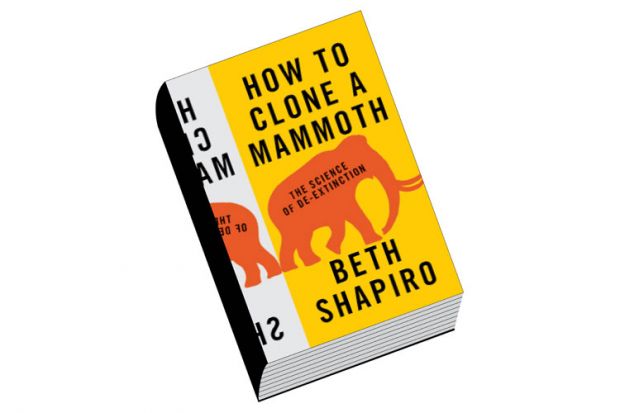“Choose an extinct species that you’d like to see brought back to life”: this was the challenge posed by evolutionary biologist Beth Shapiro to a class of her graduate students at the University of California, Santa Cruz. The responses were much as you would expect: the most spectacular and charismatic animals secured the most votes, with creatures such as the dodo, the moa and the Tasmanian tiger dominating the top slots. But surely one of the most iconic creatures in the running for best de-extinction candidate is the mammoth. What motivates us to identify these species as ideal candidates, and what should be motivating us?
Molecular technology is progressing at a remarkable speed, and the sensational de-extinction projects that were once the exclusive preserve of the Hollywood big screen are rapidly becoming the stuff of research grants. Here, Shapiro provides a (practically) practical guide to the technical processes involved in the currently theoretical process of de-extinction. However, there is not just one approach to this challenge, and much depends on what you would be prepared to accept as a successful de-extinct mammoth: is a hairy, cold-tolerant elephant with a few mammoth genes good enough? The other important question Shapiro addresses relates to the ecological implications of reintroducing a species: should this be a factor when deciding the ideal de-extinction candidate? Given the rate of progress in this extraordinary and nascent field, now is the time to be discussing these questions. After reading this book, my answer to both questions is an emphatic “yes”.
Sensational de-extinction projects once the exclusive preserve of the big screen are rapidly becoming the stuff of research grants
Bringing back a creature from beyond the grave conjures up images of Mary Shelley’s Frankenstein and Michael Crichton’s best-seller-turned-blockbuster movie Jurassic Park. But in reality, it would be a laborious and painstaking process. To clone a mammoth (that is, via the nuclear cloning methods that were used to create Dolly the sheep), the first ingredient you need is a living cell. Some extraordinarily well-preserved mammoth remains have been dug out of the permafrost in recent years, with flesh and blood still intact. However, any tissue cells have long ago ceased to function and the DNA has degraded into little more than a few meagre fragments.
Therefore, for mammoths at least, this approach is off the table. An alternative would be to cut and paste the DNA fragments together using a closely related species as a template – in this case, the Asian elephant. You would then need to identify which genes are likely to be important for controlling the physiological and behavioural characteristics of the mammoth, then splice them into the genome of an elephant and hope that they are expressed in the same way, given the different genomic background. It is a seemingly impossible task – yet tireless work by exceptional research groups is making good ground.
I was surprised to read that the current pace of progress in the field makes it more a case of when, not if, de-extinction will be successfully accomplished. Some of the molecular techniques Shapiro introduces here are complicated, but she does an admirable job of carefully navigating the non-specialist reader through the genetic tundra. And for those of you with molecular experience, the writing is engaging enough that you might find yourself itching to try out a few of the techniques yourself (if only you could get your hands on some mammoth DNA).
Turning to the practicalities, Shapiro first regales readers with the tale of Diana ben-Aaron, who, as a talented undergraduate, published a paper titled “Retrobreeding the woolly mammoth” in the MIT Technology Review – dated 1 April 1984 – that was intended as a witty parody of scientific reportage, but went on to be reported in 350 newspapers as genuine. Her paper described a successful hybridisation of elephant and woolly mammoth genomes using nuclei from a mammoth egg cell found in frozen remains uncovered in Siberia, with sperm from an Asian elephant. These hybrids were given the name “mammontelephases”. Of course, some quick fact-checking could have saved a herd of reporters from the need to make red-faced admissions to editors when the truth emerged. But despite being a spoof, ben-Aaron’s excellently written article predicted many of the technical issues faced by today’s de-extinction projects well before they were fully appreciated.
The fate of the paper highlights another important point, namely that de-extinction has the potential to capture the imagination of the wider public. This could surely be used to the advantage of those seeking research funding, with iconic creatures such as the mammoth attracting the interest (and donations) of the public. However, Shapiro cautions that “our partiality toward charismatic megafauna will lead to a taxonomic imbalance among de-extinction projects that is not unlike the imbalance that exists in conservation work”. In conservation, there is a large disparity in the distribution of funding among endangered species, with those deemed cute and charismatic typically receiving the lion’s – or rather the panda’s – share. Are these species the most integral to preserving entire ecosystems? Probably not. The same is likely to be true for de-extinction projects, and careful consideration must be given to the likely impact any reintroductions will have on the wider ecological scale.
Before we plough ahead with de-extinction, there are risks that should be mitigated. It is important to identify what caused these species to become extinct in the first place. For many of the candidate species for de-extinction, human intervention, either through overexploitation or habitat destruction, played a major role in their decline. If these issues are not resolved, history is likely to repeat itself. Some may be tempted to argue that the introduction of extinct species will restore lost habitats and rebalance ecosystems to their ancestral state. But the ecosystem, the climate and the planet are likely to have changed an enormous amount since the “resurrected” species last roamed free. Unless a species under consideration for reintroduction has only very recently been lost from the environment, initial destabilisation of the ecosystem is inevitable and long-term effects should be carefully considered.
Shapiro’s thought-provoking book offers excitement and wonder – but also comes with a warning. We must think carefully, not just about how we can achieve this incredible scientific feat, but also about where it is likely to have the most positive (or least negative) impact, and why it is worth the investment and associated risks. With this technology also comes the possibility of engineering sustainability into threatened populations. Potentially, we can apply these technologies to preventing as well as reversing extinction. While Shapiro’s message throughout How to Clone a Mammoth is unarguably one of caution, she finishes on a hopeful (and awesome) thought: using cutting-edge technology, we might be able to resurrect life that we once thought lost to us for ever, and soon. She paints a scientifically accurate yet magical world where Pleistocene giants might roam the Arctic tundra once again, and where we have the chance to undo some past mistakes – as long as we remember to keep looking towards the future.
How to Clone a Mammoth: The Science of De-extinction
By Beth Shapiro
Princeton University Press, 240pp, £16.95
ISBN 9780691157054 and 9781400865482 (e-book)
Published 13 May 2015
The author
“I live in sunny (and way too dry) Santa Cruz, California,” says biologist Beth Shapiro, “with my partner, Ed (who still hasn’t read my book), my two kids, James (5) and Henry (2), who have very little interest in natural history…yet. And two cats, who love natural history so much that they spend all of their time either mousing or trying to eat our fish that Henry lovingly (and aptly) named Fish Taco.”
Now assistant professor in the department of ecology and evolutionary biology at the University of California, Santa Cruz, Shapiro was born in Pennsylvania but raised in Georgia. “The South is known for being a little bit slower-moving and more contemplative. I like to chew on ideas for a while before writing them down, and I think this comes from my southern upbringing. Thinking about stuff for a while gives me a chance to change my mind. And then change it back again.”
“My parents would probably say I was studious,” she says of her childhood. “And my sister would say I was a nerd. I was driven to do well – to impress my parents and teachers as best I could. I had a hard time staying focused on any particular goal, however. I wanted to be a journalist neuroscientist designer geologist actress palaeontologist musician.”
Shapiro took undergraduate and master’s degrees in ecology at the University of Georgia. She was, she recalls, “definitely ambitious. I wanted to be involved in everything and go everywhere. I think I’ve made every major decision in my academic career by choosing to run with an opportunity to go somewhere that I hadn’t been before. It’s turned out ok.”
A sizeable opportunity was presented when she won a Rhodes scholarship; she would complete her DPhil at the University of Oxford in 2003. “I loved Oxford. The style of academic life was one thing that surprised me, and in a nice way. People worked hard, but they also valued conversation and collaboration in a way that I haven’t seen at my US institutions. Attendance at morning tea and afternoon coffee was mandatory (as often was the quick stop at the pub on the way home), and this is where some of the most interesting ideas and exciting experiments were born.”
Asked for her views on the University of California system’s proud legacy of public higher education and the challenges it faces owing to years of sharply reduced state funding, Shapiro observes, “I see the impact of these cuts every day. Class sizes are too large, academics are teaching too many classes, and there are too few resources to provide the kinds of hands-on learning environments – labs and field courses, for example – that should be at the core of higher education.
“The most painful result of the cuts is of course the skyrocketing cost of a UC education. Now that Jerry Brown has California’s economy back on track, it would be nice to see renewed government investment in public education. The UC system is mandated to provide an education to ‘the top one-eighth’ of the state’s graduating high school students. It would be nice if all of those students were able to afford that education,” she says.
Her generation of scholars has been disproportionately affected by growing casualisation of the academic workforce, particularly in the US. What has Shapiro’s experience been? “The system as it stands creates more [graduates] than there are academic positions. Research scientists have to have large labs in order to complete for grants and be successful in their work, which means training many more students and postdocs than there are academic positions. In my field, the biotech boom means that there are tons of opportunities in the private sector, which is good news for my students and a career path that I encourage. The same is not true across academic disciplines, of course.”
Shapiro has elsewhere admitted that her book might more responsibly be called How One Might Go About Cloning a Mammoth (Should It Become Technically Possible, And If It Were, In Fact, a Good Idea, Which It’s Probably Not). But, she adds, “I completely agree that the title as it is written is more exciting, even if it is a bit of a bait-and-switch. In fact, I wish it could have been a straightforward instruction manual. Who wouldn’t want to see a healthy herd of mammoths thundering across the countryside? It’s a magical idea that inspires curiosity – which was certainly one of my goals in writing the book. Of course, if I had to make a choice, I’d rather see healthy elephants and restored existing resources than mammoths and a resurrected Ice Age tundra.”
What if she were given the opportunity to revive an extinct creature of her choice?
“If I had to choose and were allowed to ignore the fact that it’s not possible, I would choose the dodo. It’s a sentimental choice; I did my doctoral research at the University of Oxford’s Museum of Natural History, where the most famous dodo skeleton (into whose leg I cut a small hole in 2001) is on display.
“When I was doing my dodo-related research, I became aware of how many different depictions of the dodo exist, in art, in literature, even song. What an odd and lovely bird it was! I’d love to see the dodo resurrected and reintroduced to Mauritius. Alas, the dodo became extinct not because we ate it (apparently they tasted terrible), but because the rats that were introduced to Mauritius when Dutch and Portuguese sailors first landed there ate the dodos’ eggs (which they laid in nests on the ground). It’s not at all clear that we can create a rat (and cat and pig and snake)-free zone anywhere on Mauritius that would allow dodos to get back to their awkward ways. Which really is too bad.”
What gives Shapiro hope? “People. People are obviously (and appropriately) worried about the risks involved with resurrecting extinct traits and introducing these into existing species and ecosystem. But most people are also willing to take some risk, even where that risk involves new and scary technologies, in particular as it becomes increasingly apparent that we need to do something to slow the rate of habitat loss and extinction in the present day. That gives me hope.”
Karen Shook





